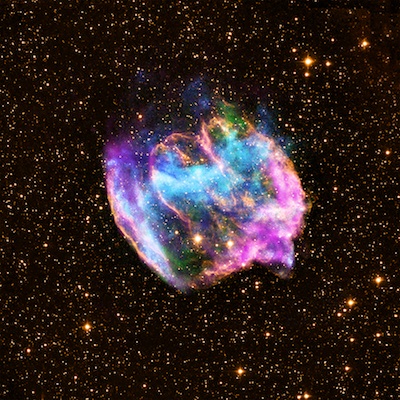Barrel-shaped blast debris may signal black hole creation
Using data from the Chandra X-Ray Observatory, Spitzer Space Telescope and the Very Large Array (VLA), a group of scientists led by Laura Lopez (MIT) and including DARK master's student, Sarah Pearson, has identified the remnant of a bipolar Type Ib/Ic supernova, the first of its kind to be discovered in the Milky Way.
Data suggest a highly distorted supernova remnant may contain the most recent black hole formed in the Galaxy. The remnant appears to be the product of a rare explosion in which matter is ejected at high speeds along the poles of a rotating star.
"It has been very exciting to be a part of this collaboration! I had worked with Laura Lopez and Enrico Ramirez-Ruiz on a previous project concerning the morphology of supernova remnants in the nearby galaxy, the Small Magellanic Cloud, during the summer of 2011. We found that these remnants were morphologically more asymmetric, than the remnants in the Milky Way. When Laura invited me to be a part of the project on the Galactic supernova remnant, W49B, during the summer of 2012, I was thrilled to get to work on the study of supernova remnants again. The fact that W49B has turned out to be of a peculiar origin, namely the death of a very massive star, made it even more interesting.
--Sarah Pearson, Dark Cosmology Centre
The remnant, called W49B, is located about 26,000 light years away and has an age of about a thousand years, as seen from Earth. “W49B is the first of its kind to be discovered in the Galaxy," said Laura Lopez of the Massachusetts Institute of Technology, who led the study. "It appears its parent star ended its life in a way that most others don't."
When a massive star runs out of fuel, the central region of the star collapses, triggering a chain of events that quickly culminates in a supernova explosion. Most of these explosions are approximately symmetrical with the stellar material blasting away more or less evenly in all directions.
In the W49B supernova, on the other hand, material near the poles of the doomed rotating star was ejected at a much higher speed than material emanating from its equator. Jets shooting away from the star’s poles mainly shaped the supernova explosion and its aftermath.
The evidence for a peculiar explosion is seen in the remnant that now glows brightly in X-rays and other wavelengths. By tracing the distribution and amounts of different elements in the stellar debris field, researchers were able to compare the data to theoretical models of how a star explodes. For example, they found iron in only half of the remnant while other elements such as sulphur and silicon were spread throughout. This matches predictions for an asymmetric explosion.

Credit: X-ray: NASA/CXC/MIT/L.Lopez et al; Infrared: Caltech/SSC/J.Rho and T. Jarrett; Radio: NRAO/VLA
"In addition to its unusual signature of elements, W49B is also much more elongated and elliptical than most other remnants," said co-author and DARK Brahe Professor, Enrico Ramirez-Ruiz of the University of California at Santa Cruz, CA. "This is seen in X-rays and several other wavelengths and points to an unusual demise for this star."
Because supernova explosions are not well understood, astronomers are keen to study extreme cases, like the one that produced W49B. The relative proximity of W49B also makes it extremely useful for detailed study.
The authors also examined what sort of compact object the supernova explosion left behind. Most of the time, massive stars that collapse into supernovas leave a dense spinning core called a neutron star. Astronomers can often detect these neutron stars through their X-ray or radio pulses, although sometimes an X-ray source is seen without pulsations. A careful search of the Chandra data revealed no evidence for a neutron star.
"It's a bit circumstantial, but we have intriguing evidence that the W49B supernova also created a black hole," said co-author Daniel Castro, also of MIT. "If that is the case, we have a rare opportunity to study a supernova responsible for creating a young black hole."
A well-known example of a supernova remnant in our galaxy containing a black hole is SS433. This remnant is thought to have an age between 17,000 and 21,000 years, as seen from Earth, making it much older than W49B.
Supernova explosions driven by jets, like the one in W49B, have been linked to gamma-ray bursts (GRBs) in other objects. Gamma-ray bursts, which have only been seen in distant galaxies, are also thought to mark the birth of a black hole. There is no evidence that the W49B supernova produced a GRB, but it may have properties in between those of a GRB and a typical supernova.
The new results on W49B, which were based on about two and a half days of Chandra observing time, appear in a paper in the February 10th issue of the Astrophysical Journal.
- Link to paper: https://iopscience.iop.org/0004-637X/764/1/50/
- More on Chandra: https://www.nasa.gov/chandra
- For an additional interactive image, podcast, and video on the finding, visit http://chandra.si.edu
- The Very Large Array: http://www.vla.nrao.edu/
- Spitzer Space Telescope: http://www.spitzer.caltech.edu/
